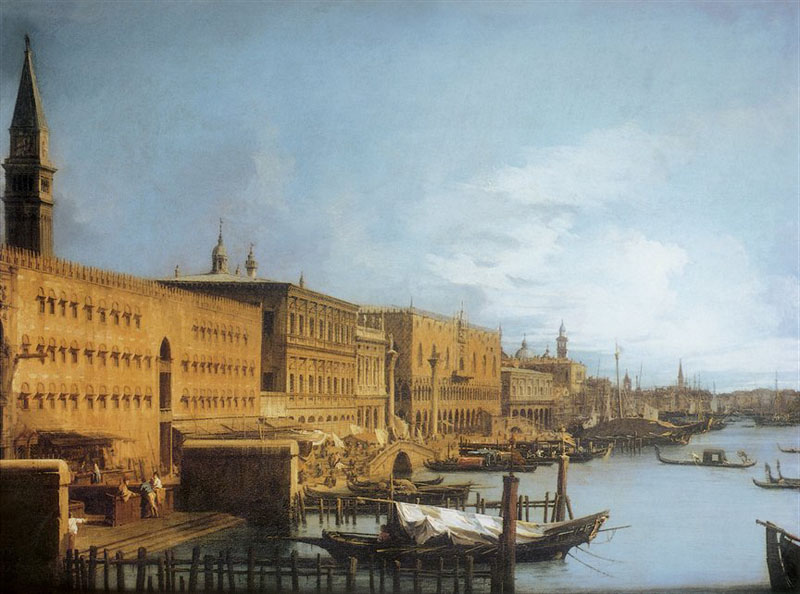13. Molo and Riva degli Schiavoni, c. 1727.
Oil on copperplate, 43 x 58.5 cm.
Private Collection.
Hardly interested in mysticism, the Venetians loved the ecstasy of religious ceremonies, the processions dazzling with priestly ornamentations, the golden dais, the unfurled banners, the doge and the patriarch, the throng of clergymen, and the six companies from the Scuole Grande.[3] For them, religion was equivalent to patriotism. Hadn’t Saint Mark’s body, which was spirited away from Alexandria, become a holy relic, a kind of Palladium? Just as the people shouted, “Siamo Venzian! e poi cristiani” (Venetian first, then Christian!), the clergy itself did not always kindly receive instructions from the Holy See. Moreover, men of the cloth had been overtaken by mistrust for the government. From the moment that a man enjoyed any benefit from the Church, be it a diploma or priesthood, he was immediately excluded from any public office and debarred from any positions he could have held. Likewise, every minister of the Republic was prohibited from appealing to the pope for a red hat, or for any prelacy.
The Inquisition still existed in Venice during the eighteenth century, but the Roman legal representatives never resembled the sinister delegates of Philip II in Spain. Moreover, three lay nobles, designated by the Senate, who had the power to annul any sentence handed down by the Holy Office, were assistants to ecclesiastical advisers. More fearsome in name than in act, this tribunal limited itself to a right to censorship only in relation to literary and artistic works. It was under this authority that Veronese was summoned to explain the presence of useless characters and improper details in his religious paintings. He used the following defence: “All of us painters are something akin to madmen and poets, acting according to the fancy and whims of our imaginations”. For his nominal “sentence”, he was forced to incorporate certain changes to the vast compositions he had painted for the refectory of the convent of Saint John and Saint Paul. One can easily foresee just how much this law of censure had become illusory during Canaletto’s time.
Trade relations brought Jews, Greeks, Muslims, and, later, Reformists, into the Piazza. The majority of European nations had a neighbourhood and a consul in Venice. For example, Jews and Greeks were stationed north of the city. However, while the Venetians wisely employed a freedom of belief in their hospitality, they rejected any doctrines. Thus, neither Luther nor Calvin counted a single one of Saint Mark’s children among their new followers. However, certain Epicurean theories, which had newly been brought to light through Cesare Cremonini’s brilliant commentaries, found more credit with them. This famous interpreter of the philosophers of Antiquity at Padua University had no fear of teaching that the soul was transmissible like the body, and thus was not immortal. Many nobles, having accepted this materialist and atheistic system, applied its conclusions to their lives. In this way, a veritable paganism was introduced not only into minds, but also into mores. This total absence of scruples had already appeared two centuries before in the influence that Aretino enjoyed. Was not his insolent pretence of posing as the arbiter of destinies tolerated? Showered with pensions and gold chains from nobles, he lived like a great lord among his contemporaries who flattered him and shuddered to see his stairs sullied by the feet of visitors who came to hear and admire him.
